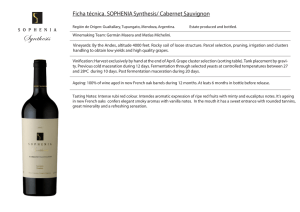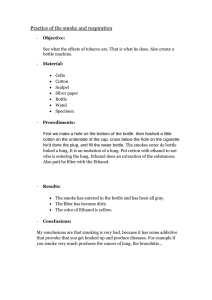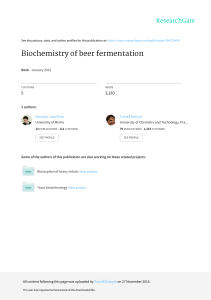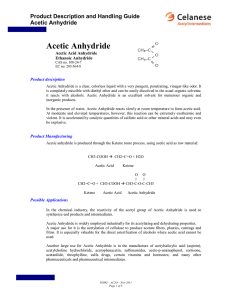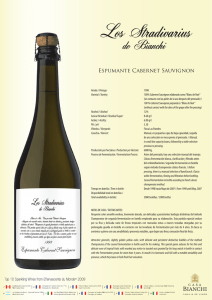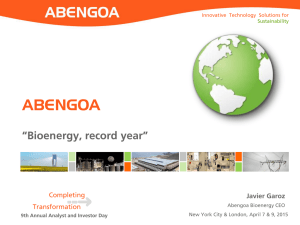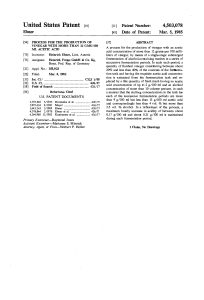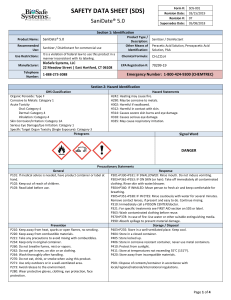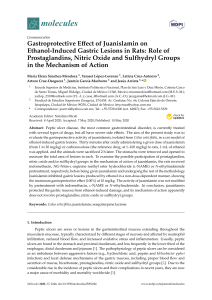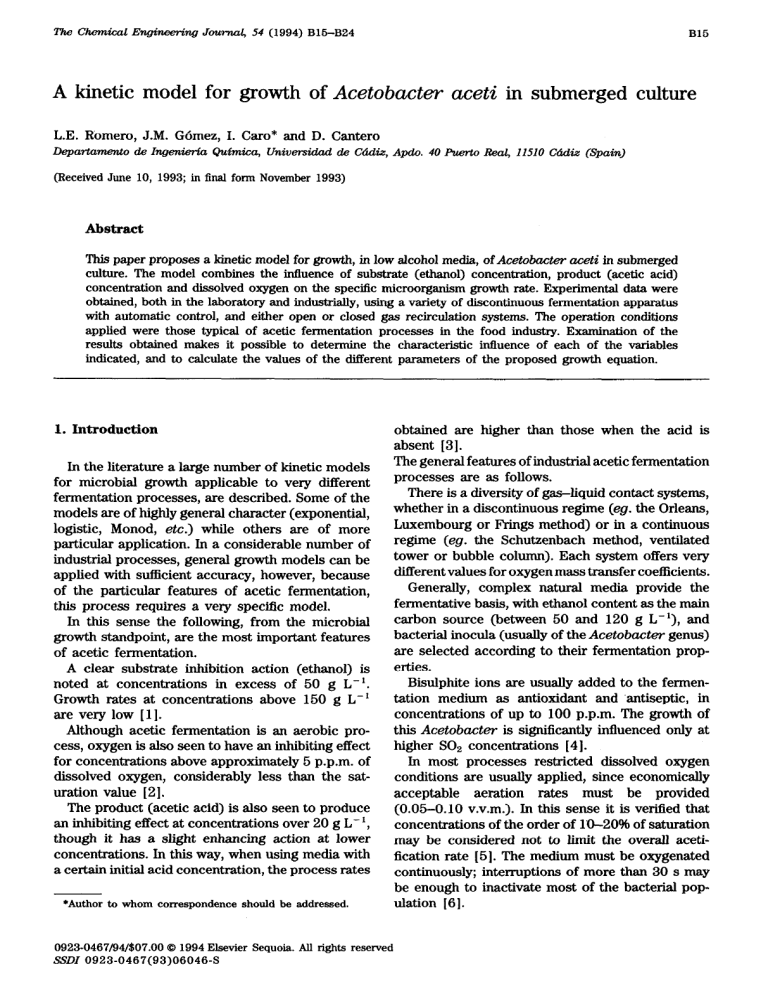
The Chemical En&z&&~ Journal, 54 (1994) Bl&B24 B15 A kinetic model for growth of Acetobuctw L.E. Romero, J.M. Gomez, I. Care* and D. Cantero DKQartamentO de I?z&?nk?k~ QuZmica, Universidad de Ccidiz, Apda (Received June 10, 1993; in final form November in submerged culture meti 40 Puerto Real, I1510 C&k (Spain) 1993) Abstract This paper proposes a kinetic model for growth, iu low alcohol media, of Acetobacter aceti in submerged culture. The model combines the infhrenceof substrate(ethanol) concentration,product (acetic acid) concentrationand dissolvedoxygen on the specific microorganism growth rate. Experimental data were obtained, both in the laboratory and mdustriahy, using a variety of discontinuous fermentation apparatus with automatic control, and either open or closed gas recirculation systems. The operation conditions applied were those typical of acetic fermentation processes in the food industry. Examination of the results obtained makes it possible to determine the characteristic infhrence of each of the variables indicated, and to calculate the values of the different parameters of the proposed growth equation. 1. Introduction In the literature a large number of kinetic models for microbial growth applicable to very different fermentation processes, are described. Some of the models are of highly general character (exponential, logistic, Monod, etc.) while others are of more particular application. In a considerable number of industrial processes, general growth models can be applied with sufllcient accuracy, however, because of the particular features of acetic fermentation, this process requires a very specific model. In this sense the following, from the microbial growth standpoint, are the most important features of acetic fermentation. A clear substrate inhibition action (ethanol) is noted at concentrations in excess of 50 g L-i. Growth rates at concentrations above 150 g L- ’ are very low [I]. Although acetic fermentation is an aerobic process, oxygen is also seen to have an inhibiting effect for concentrations above approximately 5 p.p.m_ of dissolved oxygen, considerably less than the saturation value [ 21. The product (acetic acid) is also seen to produce an inhibiting effect at concentrations over 20 g L-‘, though it has a slight enhancing action at lower concentrations. In this way, when using media with a certain initial acid concentration, the process rates *Author to whom correspondence should be addressed. 0923-0467/94/$07.00 0 1994 Elsevier Sequoia. All rights reserved SSDI 0923-0467(93)06046-S obtained are higher than those when the acid is absent [3]. The general features of industrialacetic fermentation processes are as follows. There is a diversity of gas-liquid contact systems, whether in a discontinuous regime (eg. the Orleans, Luxembourg or F’rings method) or in a continuous regime (eg. the Schutzenbach method, ventilated tower or bubble column). Each system offers very different values for oxygen mass transfer coefficients. Generally, complex natural media provide the fermentative basis, with ethanol content as the main carbon source (between 50 and 120 g L-l), and bacterial inocula (usually of the Acetobacter genus) are selected according to their fermentation properties. Bisulphite ions are usually added to the fermentation medium concentrations as antioxidant and ‘antiseptic, of up to 100 p.p.m. The growth in of is significantly influenced only at higher SOS concentrations [ 41. In most processes restricted dissolved oxygen conditions are usually applied, since economically acceptable aeration rates must be provided (0.05-0.10 v.v.m.). In thii sense it is veriiled that concentrations of the order of l’O-20% of saturation may be considered not to limit the overall acetification rate [ 51. The medium must be oxygenated continuously; interruptions of more than 30 s may be enough to inactivate most of the bacterial population [ 6 1. this Acetobucter L.E. Romero B16 et al. / Gmwth Finally, the general characteristics of the microorganism responsible for acetiflcation are as follows. In terms of pH, acetic bacteria may be said to show optimal growth in the pH range between 5.0 and 6.5 [ 71, although they show great capacity to survive at a pH of between 3 and 4 [El]. In the case of the Acetobacter aceti species, the maximum working temperature is between 30 and 35 “C [91_ However, temperatures are usually lower in industry to avoid heating costs and limit the loss of volatile compounds via evaporation caused by the aeration. The nutritional demands of the acetic bacteria are limited, their most restrictive requirements are for nitrogenated compounds, phosphates and some Bg complex vitamins. Most organic and inorganic acids can be said to have an inhibiting effect on the process [6]. It is generally well known that, in this type of fermentation, dissolved oxygen concentration is a decisive factor in the overall rate of the process. However, in dealing with the kinetic modelling of acetic fermentation, the presence of oxygen-related parameters is usually avoided. Models which include this variable have thus not been proposed, in quantitative form, using kinetic equations. 2. Present knowledge As for most fermentative models which include microbial growth, acetic fermentation is based on the consideration that the biomass present in the medium is either viable (denoted XV) or non-viable (denoted X2. The total biomass X present is the sum of these two quantities, and absolute or specific temporal variations of biomass may also be additive quantities. dX, dt 1dX _-1dX = _v XV dt XV dt 1dX + _n XV dt (I) cLp=II+& Therefore, the observed specific growth rate ,u in a culture is the difference between the overall specific growth rate pg and the overall specific death rate pd of biomass, of course with the assumption that only the viable biomass is able to multiply. In general, the influence of the different operative aceti variables on growth and death rates is modelled separately for the two phenomena, as their effect may differ in each case. One of the most recently published models for pg, provided by Nanba et al. [3], incorporates the influence of the ethanol and acetic acid concentrations on the specific growth rate of Acetobacter aceti. This model proposes a particular expression of non-competitive inhibition to reflect the inhibiting effect of the ethanol. However, the influence of the product is expressed on the basis of a specific enzymatic action model: the cooperative effects model of the special inhibition-activation type [ lo]. Relative to the cellular death phenomena and working with a continuous acetic fermentation system, Park et al. [2] proposed a direct ratio between the overall speci6c death rate and the acetic acid concentration raised to the power of four. However, Bar et al. [ 1 I] proposed an exponential ratio between these variables for discontinuous Acetobucter aceti cultures. Some of the existing general growth models described in the literature are applicable only in limiting oxygen conditions [ 1, 5 1, while others apply only in non-limiting conditions [3]. None, however, reflects the overall action of the oxygen throughout the range of operation. Therefore, this study deals with the development of a growth model for Acetobacter aceti which incorporates the combined influence of the three significant variables referred to above (ethanol, acetic acid and dissolved oxygen) throughout the entire range of operational conditions. The aim of this work is to provide a more general model of greater utility, particularly for application in processes with variable oxygen concentrations which are the standard when external oxygen control is not established. 3. Materials x=x,+x, dX d-K -_---+dt dt of Acetobacter and methods To study the growth rate of the microorganism responsible for acetiflcation from the kinetic point of view, a number of acetic fermentation experiments were carried out, in discontinuous equipment at the controlled temperature of 26 ~fr1 “C. This is the average industrial process temperature in mild zones. All cases used a submerged culture of one of the main vinegar-isolated strains, classified as Acetobacter aceti ATCC 15973. Two scales of operation were studied, one involving a 5 L stirred tank fermenter, the other a 10 000 L stirred tank fermenter. The equipment was operated with aeration rates between 0.05 and 0.5 v.v.m., and a stirring rate of 400 rev mm-‘. L.E. Romero et al. / Growth Oxygen transfer coefficients, from the gas to the liquid phase, were determined by the static absorptiondesorption method [ 12 1. They proved to be over 100 h- ’ in all systems used for the experiments, ensuring the supply of oxygen required for biomass under the different operational conditions. The fermentative medium used in all the experiments was a complex natural medium: a young wine from the Jerez winemaking area having 70-90 g L-’ ethanol; total acidity 15-20 g L-’ tartaric acid; l-2 g L- ’ sugars; 0.5-l .Og L- ’ high alcohols; 1-5 mg L-’ volatile esters; pH 2.9-3.1; 60-70 mg L- ’ sulphur dioxide. This medium was sterilised at 120 “C for 20 min and its pH was subsequently established at 4, with 1 M KOH, to provide the most suitable conditions for growth of the microorganism. The general layout of the fermentation equipment used in the different experiments is shown in Fig. 1. The fermenters were provided with a gas recirculation system making it possible to operate either in a closed system, preventing the escape of volatile compounds from the gaseous outlet flow, or else in an open system. To offset the oxygen consumption by the biomass, pure oxygen was injected discretely into the recirculation flow to the fermenter. The system had a dissolved oxygen electrode and a controller which were used to maintainthe dissolved oxygen at the required level. The experiments proceeded at a wide variety of values of this parameter within the range possible for the ethanol concentration (O-8 p.p.m.) and temperature conditions. The range of the dissolved oxygen signal error was maintained at f 10% of the set point. Fig. 1. Scheme of the experimental equipment used. A oxygen supply unit, B gas mixer and foam trap, C automatic control equipment, D discontinuous aerated fermenter, E pressure safety value. Open gas circulation system, valves 1 closed and 2 open. Gas recirculation system, valves 1 open and 2 closed. of Acetobacter aceti B17 The fermenters, containing the sterile fermentative medium, were inoculated in all cases by the addition of 10% (by volume) of a previously prepared inoculum. This inoculum consisted of an identical medium presenting a high Acetobucter uceti growth rate, obtained by parallel acetic fermentation processes in incubation chambers. Before each inoculation it was verified that the operational variables were stable and the control elements were operating correctly. To monitor the different variables during the fermentation processes, fermenter samples were taken at regular time intervals and the following assays were carried out. Ethanol and acetic acid concentration using gas chromatography [ 131;viable biomass concentration by plate count in a YEPD (10% yeast extract, 20% peptone, 20% n-glucose) medium [ 141; total biomass concentration by a Neubauer chamber count [ 151. The appropriate equipment was used to continuously monitor pH, dissolved oxygen concentration and temperature of the fermentation medium. In order to maintain a certain dimensional homogeneity in the equations of the models, total and viable biomass concentration need to be expressed in gDW L- 1 whereas the analytical procedures used in this study provide these concentrations in CFU mL- ‘. It was therefore necessary to first calculate the correlation between the two dimensions. This correlation was established by simultaneouslymeasuring, in a large number of samples, the quantity of total biomass using two different procedures: the Neubauer chamber cell count (CFU n&-r) and the dry weight of biomass (gDW L- ‘). The results are shown in Fig. 2. Following the methodology described above, a series of discontinuous acetic fermentation experiments was carried out. The experiments can be grouped according to the operational conditions and the range of values covered by the different variables throughout the process, as outlined below. Six experiments in the 5 L fermenter with an open gas circulation system. The ranges of the different variables observed during these experiments were as follows. Dissolved oxygen 7-S p.p.m.; ethanol 70-20 g L-r; acetic acid 20-70 g L-i; total biomass 0.01-0.10 g L-‘; viable biomass 1 x10-61 x 1o-3 g L--l. Five experiments in the 5 L fermenter with a closed gas recirculation system. The ranges of the variables were as follows. Dissolved oxygen l-7 p.p.m.; ethanol 70-10 g L-l; acetic acid lO-SO g L- ‘; total biomass 0.05-0.50 g L-‘; viable biomass 1x10-~-1x10-3 g L-i. L.E. Romero r et al. / Growth - = 2.25~10’ CFU/mL ‘“J9$“,, , 0 50 NEUBAUER 100 150 CHAMBER COUNT 4.2. The iqfk.mce of ethanol on growth With reference to the individual influence of substrate on microbial growth under tied acetic acid and oxygen conditions, a particular equation of the substrate inhibition type is proposed. This equation is in accordance with considerations previously mentioned in this study, and information from the literature published on the matter (1, 31. Thus, specifically, the equation proposed for the individual influence of ethanol on the specific overall growth rate is as follows. i 200 250 (1 O*CFU/mL) Correlation between the two assays of biomass concentration used, milligrams of dry weight per litre (mgDW L-‘) and colony forming units per millilitre (CFU mI_I). Fig. 2. Six experiments in the 10 000 L fermenter with an open gas circulation system. In this case the ranges of the variables were: dissolved oxygen O-l p.p.m.; ethanol 60-20 g L-‘; acetic acid 30-80 g L-‘; total biomass 0.01-0.20 g L-l; viable biomass 1 x 1o-6-1 x 1o-3 g L-l. 4. Experimental 4.1. Calculation results and discussion of specijic microbial growth rates Using the experimental data of total biomass Xi and viable biomass Xvi at time ti, the value of the overall specific growth rate pcLgi at that time can be estimated. The procedure to be followed may be based on numeric or graphic differentiation methods, depending on the type and number of accumulated experimental data. In this case, a numeric differentiation procedure was followed in accordance with the following calculation algorithm. ( )(‘Ji ( z ixVi 1 =2 (3) Where the values of the parameters must be situated within specific intervals in response to the following elrperimental factors: the maximum growth rate is obtained for values of E of about 15 g L- ‘; the growth rate drops to 20% of the maximum value for ethanol concentrations around 70 g L- ’ . The ranges of the parameters corresponding to these considerations are: KSE = 1O-30 g L- ’ and KIE = 2-4 g L- *. Moreover, the parameter p,,,& must incorporate the influence of acetic acid and oxygen, and acquires a different constant value for each pair of values of those variables. In eqn. (3), KSE can be considered a substrate saturation constant, so reflecting the metabolic affinity of the microorganism for it. Low values of the constant indicate a high microorganismsubstrate alTinity. On the other hand, constant & quantifies the inhibiting action of the substrate on growth (inhibition constant). In this case, low values for the parameter indicate a high level of substrate inhibition. 1 dx Pgi= aceti sets of experiments carried out. These data were used to study the influence of each of the variables upon microbial growth. r2 = 0,95 mgDW/L of Acetobacttw xi--xi_, ti-ti_l + X,+1 -Xi &+1-t+ 1 (2) The results obtained represent the set of specific rates pgi for different concentrations ES of ethanol, Ai of acetic acid, and Oi of dissolved oxygen, measured at each time ti. figure 3 shows the values of this specific rate, plotted in relation to the three variables under examination, for the three complete 4.3. The inqkence of acetic acid on growth To study the influence of the fermentation product on growth rate, with fixed conditions of ethanol and dissolved oxygen, an equation of the activation-inhibition by-product type is proposed. This type agrees with the particular effect of activation of growth detected for small acetic concentrations [ 31. Analogous equations have been applied to special cases of enzymatic kinetics of similar kinetic behaviours [lo]. In our case, the proposed equation is as follows. L.E. Rcmmo et al. / Growth (4) of Acetobacter B19 aceti include the influence of the ethanol and acetic acid, and it acquires a different constant value for each pair of values for those variables. The physical meaning acquired by the parameters KS0 and K,, is similar to those of the previous cases, but now referred to values for dissolved oxygen. The values of the parameters introduced must adjust to the following experimental circumstances: the maximum growth rate is obtained for values of A around 10 g L-i, this rate is of the order of 20% greater than that obtained in the absence of acetic acid and is reduced to 10% of the maximum value for acid concentrations of around 50 g L-r. The ranges for the parameters corresponding to these g L-r and considerations are: K,=lO-15 Km= 15-20 g L-l. In this case, the parameter h must include the influence of the ethanol and oxygen, and it also acquires a different constant value for each pair of values of such variables. The value of the coefficient KsA is an indicator of the degree to which the acetic acid enhances the growth of the acetic bacteria (activation constant), while the parameter Km shows the inhibiting effect of the acid (inhibition constant). 4.5. The cowzbined [email protected] of the variables From the above considerations, a general equation can be proposed for the specific overall growth rate. If it is assumed that there are no signillcant synergistic effects between the variables in question (i.e. that the overall effect observed is the product of the individual influences) then the general equation takes the following mathematical form. 4.4. The irlfluence of oxygen un growth Finally, for the individual influence of oxygen, a special inhibition equation is proposed which reflects the effect observed on growth for concentrations close to saturation [2]. The following equation is proposed for this case where pmax,GE, GE, KM, &, 0 Pgo = Pmaxo KS0 3 () 1+ $ IO In this equation there are in fact only two independent parameters, p,_o/Kso and K,,. However, three parameters are included in order to maintain the analogy with eqns. (3) and (4). Thus KS0 is actually defined according to the value obtained for p,,,ruo/KSo and to the corresponding value assigned to PmaxoIn this sense, the following circumstances must be observed for the values of these parameters: the maximum growth rate is obtained at oxygen values of between 1 and 3 p.p.m. and the rate drops to 10% of the maximum value for oxygen concentrations around saturation (8 p.p.m.). The range of the parameters corresponding to these considerationsare~_o/Kso=3-5h-‘p.p.m.-‘andKIo= l-3 p.p.m. The parameter p,,_o/Km must, in this case, @) GO ad KIo me characteristic parameters of the microorganism, and may also be influenced to a greater or lesser degree by the type of substrate @H, nutrients, inhibitors, etc.) and by the temperature. In eqn. (6), in a manner analogous to eqn. (5), %,/KS0 is a single adjustable parameter. If h acquires the physical meaning of representing the maximum observable value of pg obtained for a given concentration E,, of substrate,A,, of acetic of dissolved oxygen, then KS0 is also acid and 0, invariably defined. The proposed equation can be justified theoretically if the following considerations are made. In the first place, it is considered that the growth of the biomass is a process which depends, in energy terms, on the substrate metabolism; the greater the rate at which the cell metabolizes the ethanol, the greater the rate of specific growth. In the second place, it is considered that this metabolism comprises a chain of reactions regulated by enzymes (alcohol-dehydrogenase, aldehyde-dehydrogenase, etc.) and co-enzymes (mainly NADI-I) [ 16, 171, so that the overall process must take place at the velocity of the slowest step, and this velocity is related to the concentration of the controlling enzyme. In addition, to establish a direct relation between the growth rate and enzymatic reaction, it is necessary to consider the following approximations. L.E. Romero B20 ACETIC 0 20 40 et d. / Growth of Acetobacter aceti ACETIC (g/L) 60 60 0 100 (g/L) 20 40 60 60 100 20 40 60 80 100 0.020 I 0.06 0.015 */ .c'I: s 5 s 0.010 0.02 0.005 0.000 0.00 0 20 40 ETHANOL (aI ACETIC 0.10 0 20 40 60 60 100 (g/L) IO ETHANOL @> ACETIC (g/L) 60 60 0 100 20 40 (g/L) (g/L) 60 60 100 60 60 100 0.05 0.04 - 0.06 0.03 0.06 3 ,.z'L 5 s s 0.04 0.02 YY 0 20 40 ETHANOL cc> Fig. 0.04 60 60 100 (g/L) 3 Firstly, the controlling enzyme concentration must be constant in the viable cells, and secondly, there must be no significant inward cellular diffusional limitations on the part of the co.mpoundsincluded in the growth equation. These approximations are both reasonable if its is assumed that the viable cells have a standard enzymatic charge and good capacity for transportation of the nutrients and metabolites through their membranes. In short, bearing in mind the above mentioned considerations, the specific cellular growth rate may 0 0.02 0.01 0 Cd) 20 40 ETHANOL (g/L) (cantinued) be directly related to the rate of the enzymatic reaction controlling the energy metabolism. Therefore, on the basis of these considerations, the proposed kinetic growth equation (eqn. (6)) may respond to the enzymatic action mechanism in the reaction. Because enzymatic action mechanisms are generally quite complex, it is difhcultto deduce precisely the kinetic pattern of the microbial growth controlling step on the basis of the experimental work developed in this study. However, Fig. 4 is included L.E. Romero ACETIC et al. / Growth of Acetobacter aceti (g/L) B21 ACETIC (g/L) ‘1 s 0.010 - 0.005 - 0.000 1 / 0 20 6 I I I 40 60 80 100 ETHANOL (e> (g/L) 0.000 1 0 (0 I 20 \ 40 ETHANOL 60 , I 80 100 (g/L) Fig. 3. Set of experimental data on overall specific growth rate as a function of the three variables examined (ethanol, acetic acid and oxygen). (a) 0.5 p.p.m. oxygen; @) 1.0 p.p.m. oxygen; (c) 3.0 p.p.m. oxygen; (d) 4.5 p.p.m. oxygen; (e) 6.0 p.p.m. oxygen; (f) 7.0 p.p.m. oxygen. z =enzyme E = ethanol O=oxygen A= acetic acid ZE,C Z+2A lO\’ Z+A ,+Ev ZEA, 7 fE/'I ZE,A,% ZA,' Equilibrium constants K, = K,,= K,,= K, K,,= K, = K,,= K, K,=K,=K. G=K3=K,o F’ig. 4. One of the possible enzymatic mechanisms corresponding to the proposed mathematical growth equation. By applying steady state considerations and the set of special simplifications summarked at the bottom of the figure, eqn. (6) can be obtained. to show that there might be some potential mechanisms which respond well to the proposed mathematical equation (eqn. (6)). This scheme takes into account a large number of simplifications, but it is a proposal completely in line with the kinetic behaviour generally observed in the growth of Acetobacter aceti in submerged cultures. 4.6. Values calculated for the coe&ients To obtain the mathematical adjustment of the coefficients in eqn. 6, a non-linear regression procedure was used based on Marquardt’s algorithm [ lg]. Application of this procedure to the set of experimental data in Fig. 3 gave the following values of the parameters. p-=0.22&0.02 h-‘, &,=21.lf6.7 g L-‘, J&=12.6+2.5 g L-l, &,=0.372+0.05 p.p.m., J&=2.83&0.2 g L-‘, K,=17.9+1.2 g L-‘, K,,=1.958*0.21 p.p.m., r ’ = 0.9 7. The following considerations may be made in relation to this set of adjusted values. In the first place, the value of the coefficient KSE indicates a high metabolic affinity of Acetobacter aceti for ethanol (compared with the value KSG= 112 g L- ’ [ 19] in the case of Saccha~~ces cerevisiae yeast for glucose in one of the best exploited industrial fermentation systems, alcohol fermentation). Secondly, the value of KIE shows that ethanol markedly inhibits the growth of Acetobucter aceti, as would be expected from a compound of general antiseptic nature such as ethanol. Other non-antiseptic substratesusually show a much lower level of inhibition, hence KIG=28.8 g L-’ for inhibition of the growth of Bvpionibacteriumfreundeureichii by glucose [ 201. In consequence, on the basis of the parameter values obtained, the optimal ethanol concentration E for the growth of Acetobacter aceti is 12.99 g?P_ In reference to the product coefficients, the value for Kti shows that acetic acid has a certain enhancing effect on the growth of the bacterium. This effect of acid compounds is not usually noted on microorganisms, except where they are adapted to such conditions. However, the value of the KN parameter B22 (a> L.E. Rmm-o ACETIC et al. / Growth of Acetobacter anti (g/L) l-4 (h-’ (g/L) Fig. 5. Graphic representation of the proposed equation (eqn. (6)) for different parameter values calculated from the experimental data. (a) 1.5 p.p.m. oxygen; (b) 10 g L-’ acetic acid. shows that this acid has a significant inhibiting effect on growth. As a reference value, I& = 50 g L- ’ for the effect of ethanol on the growth of Sacchcwomyces cerevtiti during alcohol fermentation [ 191. As a consequence, according to the parameter values obtained, the optimum acetic acid concentration A, for the growth of the bacterium under examination is 9.95 g L-‘. L.E. Romero et al. / Growth of Acetobacter As to the oxygen coefficients, the reduced value of KS0 shows the high aillnity of this bacterium for oxygen, clear evidence of its nature as a strictly aerobic microorganism. However, the second oxygen coefficient value K,, shows that, in conditions of high aeration, there is a significant inhibition of growth. While this effect might in principle be abnormal, it has commonly been noted in a large number of aerobic microorganisms when there are high oxygen concentrations in the medium. In such conditions, the redox systems in those cells are unbalanced with a resulting general&d loss of control of their metabolic pathways. The optimum dissolved oxygen concentration 0, for the growth of Acetobucter is 1.55 p.p.m., calculated from the parameter values obtained. F’inally, the value obtained for CL_ under the experimental conditions is slightly lower than the values obtained under other conditions [ 1, 2, 31, demonstrating the high dependence of this parameter upon other operational variables such as temperature orthe characteristicsof the culturemedium. In this sense, it must be pointed out that the presence of growth inhibitors (such as sulphur dioxide) may be decisive for the overall value observed. Figure 5 shows the dependence of the overall specillc growth rate on the three variables studied under the experimental conditions used here. This representation corresponds to the plot of eqn. (6) for the coefficient values set out above. 6. Conclusions general by three types of inhibition, substrate (ethanol), product (acetic acid) and oxygen, when these compounds are present in the fermentation medium in high concentrations. Moreover, it is also con&rued that the main fermentation product does to some degree enhance growth. These effects are contained with sufficient accuracy in the proposed growth equation (eqn. (6)), whose theoretical basis lies in the mechanisms of enzymatic action. In addition to the theoretical basis referred, the equation is highly useful thanks to its entirely separate consideration of the influences of the different variables on the specific growth rate. F’inally,the parameters introduced into the equation take on a simple physical signillcance, and their adjusted values enable interesting calculations to be applied in the design and development of industrial acetic fermentation processes. In this sense the estimated optimum concentrations for B23 growth are: ethanol 13 g L-l, acetic acid 10 g L-‘, oxygen 1.6 p.p.m. Acknowledgments The authors wish to thank the company Pedro Domecq, S.A. for its collaboration in this study, in the supply of raw materials, microorganisms and industrial fermentation equipment, and for its financial support in the form of research grant no. lIO-100/92. References 8 9 10 11 In the first instance it is confirmed thatAce&kcter uceti growth in alcoholic substrates is affected in aceti 12 13 14 15 16 17 18 19 20 M.H. Cho and S.S. Wang, BiotechmL Prog., 6 (1990) 164-167. Y.S. Park, H. Ohtake and M. Fukaya, J. Ferment. Bimng., 68 (2) (1989) 96-101. Techrwl., A. Nanba, A. Tamura and S. Nagai, J. Fmmmt. 6 (1984) 501-605. S. Lafon-Lafourcade and A. Joyew, BulL OlV, 608 (1981) 803-829. N.M. Oosterius, N.M. Groesbeck, N.W.F. Kossen and E.S. Schenk, AppL MicrobioL BiotechnoL, 21 (1985) 4249. G.S. Drysdale and G.H. Fleet, Am. J. EnoL V&G., 40 (1989) 99-105. J. De Ley, M. Gillis and J. Swings, In J.G. Holt (ed.), Bergey’s Mamml of Systematic Bacteriology, 9th edn., Vol. I, Williams and Wilkins, Baltimore, 1984, pp. 276-284. J.J. Cho and A.C. Hayward, J. MicrobioL SeroL, 46 (1980) 191-204. J. De Ley and J. She&J. Gen. MicrobioL, 33 (1963) 243-263. M. Dixon and E.C. Webb, Enzymes, 3rd edn., Longman, New York, 1979, pp. 399-467. R. Bar, J.L. Gainer and D. Khwan, BiotechnoL Bioeng., 29 (1987) 796-798. B. Atkinson and F. Mavituna, Biochemical and B&tech nolosy Handbook, Stockton Press, New York, 1987, pp. 737-739. J. Sanz, I. Martinez-Castro, G. Reglero and M.D. Cabezudo, Analytica Chimica Acta, 194 (1987) 91-98. G.S. Drysdale and G.H. Fleet, Am J. EmL Vitic., 2 (1988) 143-154. W.F. Harrigan and M.E. McCance, Laboratory Methods in Food and Dairy Microbiology, Academic, New York, 1966, pp. 37-42. T. Nakayama, J. Biochenh, 2 (1961) 158-163. T. Nakayama, J. Biochem, 3 (1961) 240-261. D.W. Marquardt, J. Sot. Ind. AppL Math., 11 (1963) 431-441. R. Boulton, BiotechnoL Bioeng., 9 (1979) 167-177. J.C. Heuvel and H. Beeftink, BiotechnoL Bioeng., 31 (1988) 718-824. Appendix ( Ii A A: Nomenclature value for the instant i acetic acid concentration (g L-‘) B24 E Ku 47. 0 r2 t ti-1 ti X X, L.E. Rowzero et al. / Growth of Acetobacter aceti ethanol concentration (g L-l) inhibition constant referred to species j (g L- ‘, p.p.m.) saturation constant referred to species j (g L- I, p.p.m.) oxygen concentration @p.m.) non-linear determinating coefficient time Q initial instant of a given interval i (h) final instant of a given interval i (h) total biomass concentration (gDW L- ‘) non-viable biomass concentration (gDW L- ‘) X” : max viable biomass concentration (gDW L- ‘) parameter or variable Y at instant i parameter or variable Y corresponding to PnIax Greek P CLL! CL&3 CL.3 Pmax Pmrqj letters observed specific growth rate (h-l) overall specifk growth rate (h-l) specific growth factor for species j (h-l) overall specific death rate (h-l) maximum observed specific growth rate (h-l) maximum specifk growth factor for species .i 01-7

